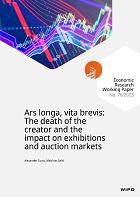Ars longa, vita brevis: The death of the creator and the impact on exhibitions and auction markets
Economic Research Working Paper No.76
Author: Alexander Cuntz
Author: Matthias Sahli
Publication year: 2023
DOI: English

This paper studies the death effect on artists’ exhibitions and commercial success in the secondary art market. Based on a random sample of 1’000 popular artists born after the turn of the 20th century, we construct a novel panel data set of their worldwide exhibition history and auction transactions. By applying a regression discontinuity and event study design, we find an overall negative effect of artist death on the number of exhibitions. However, this post mortem effect disappears in longer term. Roughly ten years after death, exhibitions are back to pre-death levels. Arguably, transaction cost and higher auction prices after death also temporarily increase the average cost of exhibiting artworks, e.g. higher market valuation raises (unobserved) insurance cost for exhibitions. Hedonic auction price models confirm this intuition and suggest a significant price premium posthumously. We find substantial heterogeneity in the treatment depending on the age and reputation of the artist at death. Overall findings explain important mechanisms for the post mortem value of artistic work and have important policy implications for the creative sectors and the design of legacy stewardship rules, including a possible justification for rights granted post mortem such as copyright.
